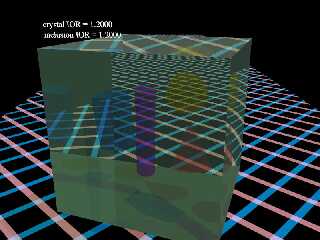|
 |
Thomas de Groot <tho### [at] degroot org> wrote:
>
> You didn't say, but I suppose that the
> 'union' renders faster than the 'difference'. Additionally, using blobs
> as inclusions, especially if there are many of them, will speed up
> render time.
My current machine is so fast that I didn't even notice a difference in render
times! But I went back and noted the times: 2.067 sec for union, 2.138 sec for
difference. So yes, the union is faster. BTW, I have almost never experimented
with blobs(!); I need to do that. I still find it amazing that they render
faster in a 'difference' than even simple spheres do-- because I assume that
they are far more complex as math constructs.
BTW, I forgot to mention that my previous image post did not include media,
although I plan to experiment with that addition as well.
There is an interesting difference in how POV-ray treats media vs. ior regarding
embedded objects, which might be unexpected to a new user: Embedded objects with
different iors show the ior changes, whereas embedded media objects do NOT show
their different
media method...
intervals...
samples...
For media, the only values recognized for those settings are from the first
object 'surface' that the camera ray 'sees'-- which is the larger container
object. The inner-object values, if different, are ignored, and take on the
outer object values. It might be assumed that the ior and media 'mechanisms' --
both being interior{...} attributes-- would work the same way, but they don't.
> > [Kenneth wrote:]
> > I have not yet tested my scene to discover how the different iors
> > affect each other-- i.e., simple addition vs. multiplication of the
> > iors. That's difficult to tell, visually. I suspect that it's
> > just addition.
This situation is not quite what I originally thought, although it *is* simple
addition, in a different form: From further tests, I see that the different
iors interact like this example:
crystal ior (the container): 1.2
inclusion ior: 1.2
When they are the *same*, the inclusions do not show any 'additional' ior effect
-- like an additional 0.2 for themselves, above the container's 1.2-- but just
the overall ior of 1.2... as if the container and the inclusions are all "made
from the same material" (whether as a union or a difference). I guess that I
should have expected this-- it seems obvious now-- although I originally thought
that the inclusions would show 1.2 + 0.2 = 1.4.
BTW, I also discovered something interesting along the way:
An ior of 0.0 is the same as ior 1.0. This has actually confused me in the
past-- because 'negative' iors ( < 1.0 and even < 0.0) can be used for
interesting effects, but there is this unexpected 'glitch' at exactly 0.0. org> wrote:
>
> You didn't say, but I suppose that the
> 'union' renders faster than the 'difference'. Additionally, using blobs
> as inclusions, especially if there are many of them, will speed up
> render time.
My current machine is so fast that I didn't even notice a difference in render
times! But I went back and noted the times: 2.067 sec for union, 2.138 sec for
difference. So yes, the union is faster. BTW, I have almost never experimented
with blobs(!); I need to do that. I still find it amazing that they render
faster in a 'difference' than even simple spheres do-- because I assume that
they are far more complex as math constructs.
BTW, I forgot to mention that my previous image post did not include media,
although I plan to experiment with that addition as well.
There is an interesting difference in how POV-ray treats media vs. ior regarding
embedded objects, which might be unexpected to a new user: Embedded objects with
different iors show the ior changes, whereas embedded media objects do NOT show
their different
media method...
intervals...
samples...
For media, the only values recognized for those settings are from the first
object 'surface' that the camera ray 'sees'-- which is the larger container
object. The inner-object values, if different, are ignored, and take on the
outer object values. It might be assumed that the ior and media 'mechanisms' --
both being interior{...} attributes-- would work the same way, but they don't.
> > [Kenneth wrote:]
> > I have not yet tested my scene to discover how the different iors
> > affect each other-- i.e., simple addition vs. multiplication of the
> > iors. That's difficult to tell, visually. I suspect that it's
> > just addition.
This situation is not quite what I originally thought, although it *is* simple
addition, in a different form: From further tests, I see that the different
iors interact like this example:
crystal ior (the container): 1.2
inclusion ior: 1.2
When they are the *same*, the inclusions do not show any 'additional' ior effect
-- like an additional 0.2 for themselves, above the container's 1.2-- but just
the overall ior of 1.2... as if the container and the inclusions are all "made
from the same material" (whether as a union or a difference). I guess that I
should have expected this-- it seems obvious now-- although I originally thought
that the inclusions would show 1.2 + 0.2 = 1.4.
BTW, I also discovered something interesting along the way:
An ior of 0.0 is the same as ior 1.0. This has actually confused me in the
past-- because 'negative' iors ( < 1.0 and even < 0.0) can be used for
interesting effects, but there is this unexpected 'glitch' at exactly 0.0.
Post a reply to this message
Attachments:
Download 'identical_iors_jpeg_file.jpg' (75 KB)
Preview of image 'identical_iors_jpeg_file.jpg'

|
 |




![]()